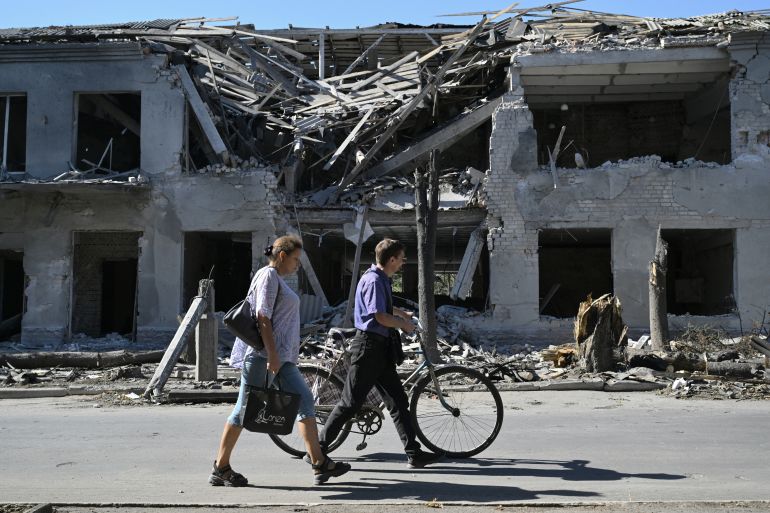Russia-Ukraine war: List of key events, day 943
As the war enters its 943rd day, these are the main developments.
Pokrovsk residents walk past a badly damaged building as Russian forces continue to taregt the city [Genya Savilov/AFP]Published On 25 Sep 202425 Sep 2024
Here is the situation on Wednesday, 25 September, 2024.
Fighting
At least three people were killed and 34 injured after Russia struck a Kharkiv apartment block in a guided bomb attack. The northeastern city, which lies close to the Russian border, is the second biggest in Ukraine.
At least seven people were injured in a Russian attack on the southern city of Zaporizhzhia, which has been targeted in a series of strikes in recent days.
Zaporizhia regional Governor Ivan Fedorov, meanwhile, accused Russia of “hunting civilians” after a man was shot dead in a village by a first-person-view (FPV) Russian drone.
At least two people were killed in a Russian artillery attack on a residential area in the eastern town of Pokrovsk, Donetsk regional prosecutors said.
One person was killed and two injured in a Russian guided bomb attack on two unspecified infrastructure facilities in Kostiantynivka, Donetsk regional Governor Vadym Filashkin said on Telegram.
Russian war bloggers and state media said Russian forces began storming the eastern Ukrainian town of Vuhledar, which had a population of more than 14,000 people before the war. Ukraine’s military said Russian troops had launched eight attacks around the town and two nearby villages, and that four had been repelled.
A Russian attack on Ukraine’s central region of Poltava damaged energy infrastructure and cut off power to 20 settlements.
The Ukrainian Air Force said Russia launched 81 drones and four missiles to attack the country overnight from Monday into Tuesday. The air force said it shot down 66 drones and that it lost track of 13 more in several Ukrainian regions.
Russia’s Ministry of Defence said its air defence units destroyed 13 Ukrainian drones – six each over the Belgorod and Kursk regions, and one over the Bryansk region.
Politics and diplomacy
Ukrainian President Volodymyr Zelenskyy told the 15-member United Nations Security Council that Russia’s war on Ukraine could not be ended by talks alone and that Moscow had to be forced into peace. Zelenskyy said Moscow was the “sole aggressor” in the war and accused North Korea and Iran of being “de-facto accomplices” for providing Russia with arms.
US Secretary of State Antony Blinken and China’s Foreign Minister Wang Yi clashed during the meeting after Blinken accused China of providing Russia with technologies that were allowing Russia “to rebuild, to restock, to ramp up its war machine”. Wang rejected the accusations. “I wish to make it clear that on the Ukraine issue, any move to shift responsibility onto China, or attack and smear China, is irresponsible and will lead nowhere,” he told the council.
Speaking at the UN General Assembly, Brazilian President Luiz Inacio Lula da Silva championed Brazil and China’s proposal for talks between Russia and Ukraine to end the war. The six-point plan calls for de-escalating the situation and the resumption of direct dialogue without requiring Russia to pull back. Zelenskyy has already rejected the plan as “destructive”.
Ukraine’s Finance Minister Sergii Marchenko said the country will spend 2.22 trillion hryvnia ($54 billion) on “national security and defence” in 2025. The sum represents about 26 percent of Ukraine’s gross domestic product (GDP) and 61 percent of the government’s overall budget.
Russia said it planned to raise budget spending by 9 percent to 41.5 trillion roubles ($446.2bn) in 2025. Finance Minister Anton Siluanov said the focus would remain on military needs.
Russian lawmakers approved new measures to allow the army to recruit defendants who are currently on trial. Criminal proceedings would be suspended during the defendant’s time with the military, and dropped if they receive a state award or were discharged under normal circumstances, such as being wounded in combat, the State Duma said.
Weapons
Ukraine’s presidential adviser Vladyslav Vlasiuk said about 60 percent of the foreign parts found in Russian weapons on the battlefield in Ukraine had been delivered to Russia via China. Vlasiuk said China was itself supplying Russia, as well as being a transit route for Western products noting that important parts used in surveillance, drones and missiles had also originated from countries including the United States, the Netherlands, Japan and Ireland.
